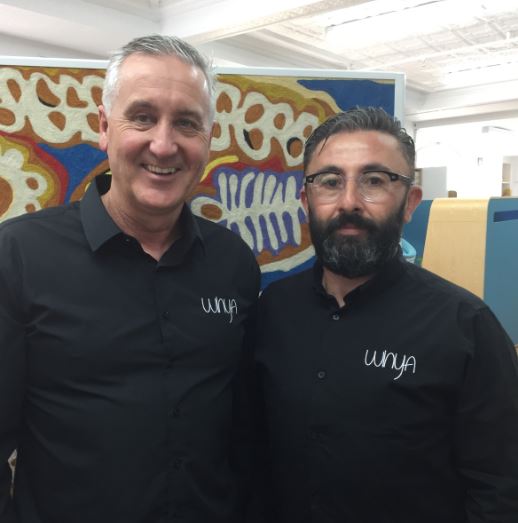Five Indigenous artists and designers exhibited at the world’s biggest furniture expo in Milan, the 58th Salone Del Mobile, from 7-14 April.
Among them, Aboriginal artist Danielle Mate Sullivan, who also paints acrylic designs onto furniture.
“I’m painting landscapes on the chairs and on my big pieces in Milan, and I’ll be using this same technique. So it’s quite a raw way I suppose of using the brush,” Ms Sullivan said.

Indigenous artist Danielle Mate Sullivan painting in front of visitors at the furniture fair in Milan. Source: SBS
The Murrawarri woman grew up in Sydney’s southwest and also works with troubled youth, teaching them about the importance of connection to country.
“I am inspired by the natural landscape patterns and textures.”
Ms Sullivan was proud to represent her culture in Milan, in front of 500,000 visitors. She’s used to her art to provoking strong reactions.
“A woman started crying [while looking] at my work. So that was unforgettable! And that’s what art can do,” Ms Sullivan said.
“Aboriginal art is any art made by an Aboriginal person, it doesn’t need to be dot work or traditional colours or ochres, and that’s what is exciting.”
Global exposure
Greg Welsh is the director and co-founder of Winya furniture, the only Australian Indigenous business to take part in 58 years.
“To be on the stage at the world’s most important furniture show was just outstanding for us,” he said.
The artists in Milan include designer Matthew Fellingham, whose lighting incorporates Sullivan’s painting.
“To showcase us on this pivotal stage is absolutely breathtaking and amazing, so proud to be part of it,” Mr Fellingham said. Winya is a majority Indigenous owned and controlled business which supplies office furniture through Indigenous employment-focused manufacturing.
Winya is a majority Indigenous owned and controlled business which supplies office furniture through Indigenous employment-focused manufacturing.

Indigenous artists are with Winya Furniture, showcasing their work at a global trade fair, Salone del Mobile, in Milan. Source: SBS
“The fabric designs are commissioned from communities in remote areas of Australia,” Mr Welsh said.
“And we’re placing Indigenous people into factories that make our lounges and chairs, and they’re getting trained through full-time apprenticeships and traineeships to do woodwork and upholstery.”
Indigenous tourism
There were 9.3 million visitor arrivals in Australia, for the year ending January 2019, an increase of 5.5 per cent on the previous one.
Increasingly, international tourists want to engage with Australian Indigenous artists and many visitors have arts high on their itineraries.
An Australia Council report found that more than 820,000 international tourists engaged with First Nations arts while in Australia in 2017, an increase of 41 per cent in five years.
Data from Tourism Research Australia (TRA) shows that international arts tourism has grown at a higher rate than overall international tourism, over the past five years.
"Audiences are drawn to Australia’s unique First Nations arts and cultures," said Dr Wendy Were, Executive Director at Australia Council for the Arts.
Engagement with Indigenous culture was higher for visitors who travelled beyond metropolitan areas. Of arts tourists who visited Darwin, 63 per cent attended a First Nations arts activity in Australia. Leetina Smith is Aboriginal outcomes senior program manager for NSW FACS (Family and Community Services). She welcomed the rise in tourists to NSW's rural communities, where many people are struggling with impacts of drought.
Leetina Smith is Aboriginal outcomes senior program manager for NSW FACS (Family and Community Services). She welcomed the rise in tourists to NSW's rural communities, where many people are struggling with impacts of drought.

Winya Furniture Director Greg Welsh and lighting designer Matt Fellingham are in Milan this week. Source: SBS
“It’s really good to get the tourists out in regional NSW to where the artists are on country, because the drought is affecting us and many small business are closing. So it’s great to support those artists and to encourage our youth.”
The Milan trip was supported by the Department of Foreign Affairs and Trade (DFAT).
A spokesperson for the department said it was “an important opportunity to target and engage the Italian and broader European markets, while publicly profiling the success of Australian Indigenous design and furniture making.”
“DFAT is committed to enhancing Australia’s reputation as a creative nation by promoting excellence in design, architecture, film, fashion, music and arts. Our creativity underpins and strengthens our trade and investment links with the world, building networks, collaboration and exchanges that expand audiences and markets for Australian exports generally”.
Arts tourism in Australia is expected to continue growing, amid predictions international visitor numbers will rise to 10 million this year.

